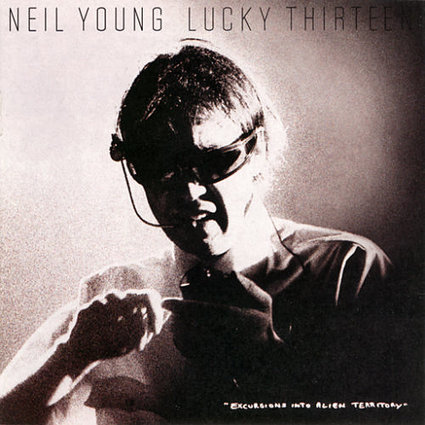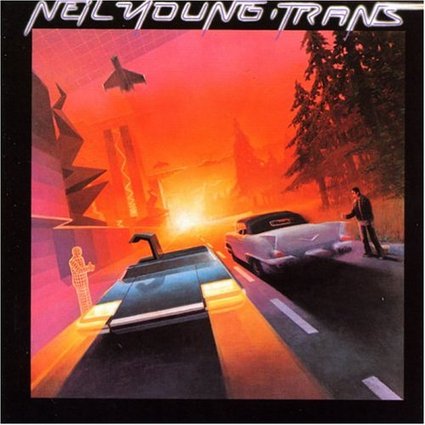Each week, Frequency Rotation probes a different song with a speculative-fiction theme. Genre, musical quality, and overall seriousness may vary.
When you think of cyberpunk, who’s the first musician that springs to mind? Billy Idol? Please. Naturally, it ought to be Neil Young.
Yes, Neil Young is an old hippie. So is William Gibson—and that didn’t stop him from writing Neuromancer, the high-tech thriller that almost singlehandedly booted the cyberpunk genre in 1984. Two years before that, though, crusty ol’ Neil threw fans and critics for a cybernetic loop of his own with his album Trans. The negative (or just plain baffled) reaction Trans elicited is understandable. The album doesn’t sound remotely like Young—which is exactly how he wanted it. Ever the iconoclast, he risked everything to make an album that bypassed his usual moody folk-rock and twangy proto-grunge in favor of… synthesizers and robot voices? Apparently Young had some cold, hard chrome lurking underneath all those ratty flannel shirts.
One of Trans’ many science-fiction-themed tracks is the frigid, digitized, thoroughly un-hippie-like “Sample and Hold,” a tale of loneliness in some bleak future stocked with mail-order android brides. “We know you’ll be satisfied / When you energize / And see your unit come alive,” drones Young emotionlessly in a completely unrecognizable mutation of his trademark nasal tenor. “We know you’ll be happy.” On his 1993 compilation Lucky Thirteen, Young would release an extended remake of “Sample and Hold”—a full eight minutes of Blade Runner-worthy cyber-rock. And just to drive the SF motif home, the cover of Lucky features a photo of Young decked out like an extra from Tron—and even comes with the subtitle “Excursions into Alien Territory.”

Factoid: The robotic voice on “Sample and Hold” (and most of the rest of Trans) comes from a gizmo called the vocoder. Before Auto-Tune became all the rage with pop stars, vocoders were the go-to gadget for modulating the human voice to sound icy and mechanized—kind of like when you’d talk into a box fan when you were a kid, times a hundred. The vocoder was very much in vogue in 1982, just as Young was making Trans. At the time, however, vocoders were mostly used by futuristic electro pioneers like Jonzun Crew and Afrikaa Bambaataa—not to mention the mighty and unclassifiable Kraftwerk, whose synth-and-vocoder-based Computer World came out in ’81.
There’s no denying that the songs on Trans, particularly “Computer Age” and “Computer Cowboy,” were very much influenced by Kraftwerk’s Computer World. The fact that Young—a purveyor of organic guitars and gritty, mystical Americana—was a fan of stiff, German synthesizer music speaks volumes about the man’s legendary eccentricity, not to mention his loyalty to his fellow weirdoes. Young, remember, was also an early champion of Devo—and even funded the surreal, post-apocalyptic comedy Human Highway, in which Young and Devo costar and jam together jarringly on Young’s anthemic “Hey Hey, My My.” (Be warned: Prolonged exposure to this clip may induce seizures.)
But there was an even more profound influence on Trans, one that pretty much defuses any charge of pretentiousness that can be leveled at Young. His son, Zeke, was nine years old when Trans was being made; diagnosed with cerebral palsy at birth, Zeke had responded unusually well to his father’s voice when he heard him tinkering with a vocoder. That inspired Neil to turn Trans into a tribute of sorts to Zeke. Rife with visions of virtual-reality wonder and remote-control adventure, the album takes on a whole new light: Rather than being a piece of ridiculous self-indulgence, it’s a portal to the imagination Young opened up for his wheelchair-bound little boy.
As such, Trans is a heroically selfless album, one that could very well have ended Young’s career. In fact, it almost did end his career. After Trans, Young’s eccentricity spiraled downward as he released flop after oddball flop (that is, before returning to his roots in the late ’80s, just as the up-and-coming grunge scene started claiming him as a godfather). Longtime fans of Young, though, shouldn’t have been so shocked at his geeky SF fetish. Way back in 1970—while William Gibson was just another scruffy draft-dodger dropping acid in Canada—Young had already stared at the sky and sung longingly about “silver spaceships flying in the yellow haze of the sun.”
Jason Heller writes for The A.V. Club, plays guitar, and entered this world the week Neil Young’s “Heart of Gold” was #1 on the charts.










